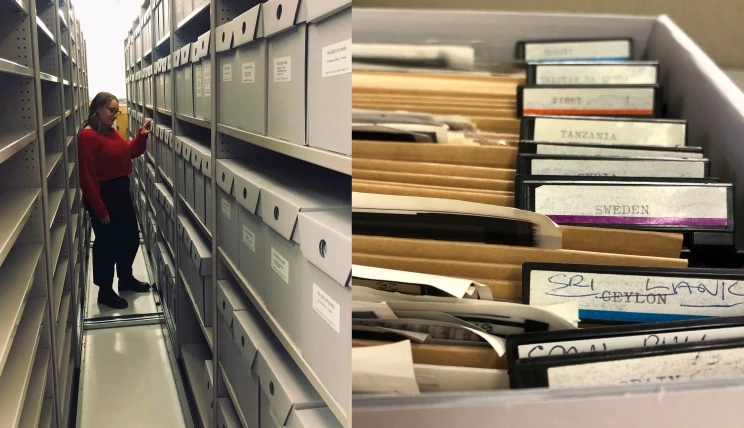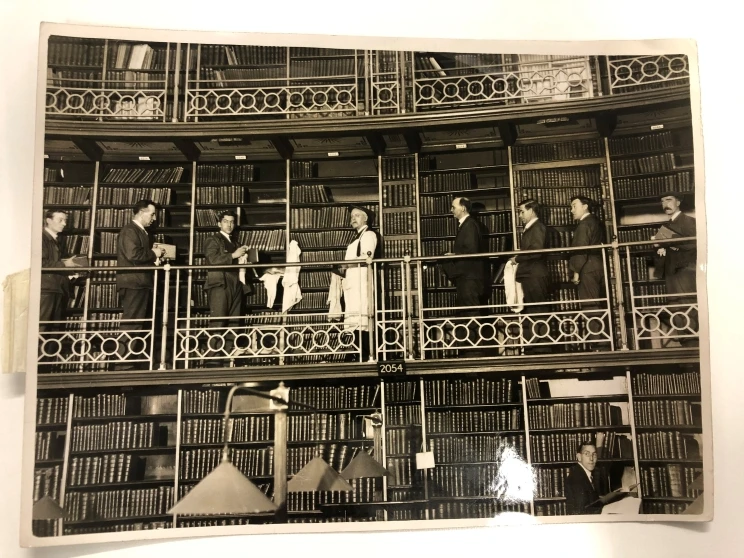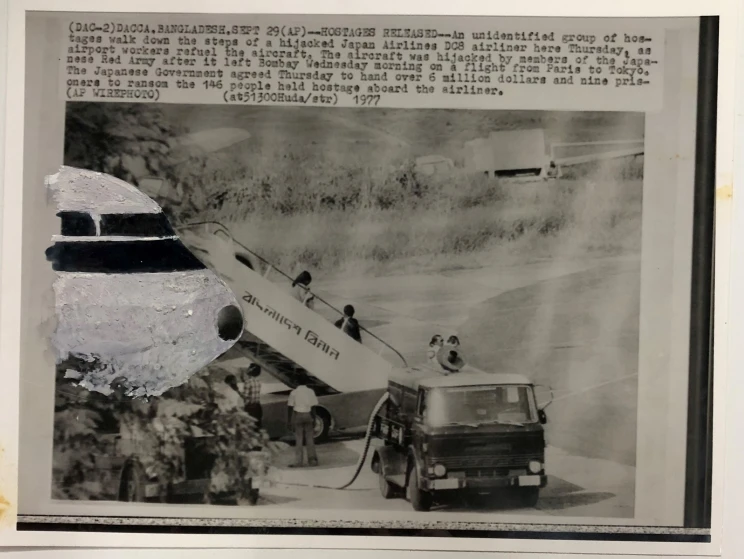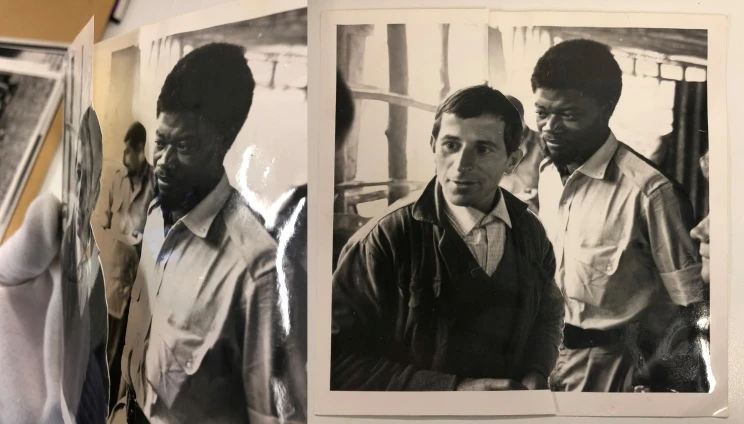Processing ‘The Evening Post’ International Collection — an update
Masters student in Museum and Heritage Practice at Victoria University of Wellington, Brianna Gillanders writes about the significance of ‘The Evening Post’ International Collection as a resource for researchers.
Photographic prints from The Evening Post newspaper
For the duration of my 120-hour placement at the Alexander Turnbull Library, I was tasked with contributing to the project of processing The Evening Post International Collection of photographic prints (Series-6678).
This was a continuation of the work of Clara Souza da Frota who processed nearly 90 boxes of the collection during her internship over the last summer.
Read the blog Clara wrote about her experience.

L: The author with the Evening Post International Collection held in the Alexander Turnbull Library. Photo: Sascha Nolden. R: One of the many boxes in the collection with files for Spain PAColl-10755-1487 to Turkey PAColl-10755-1502. Photo: Brianna Gillanders.
People, places, and events from the 20th century
The Evening Post collection spans from 1927 to 2001 and comprises an eclectic mismatch of both published and unpublished images of people, places, and events from a large portion of the 20th century.
The Alexander Turnbull Library began accessioning the collection in 1963 up until the paper closed its doors in 2002. The international print section has largely gone untouched for the twenty years since then.
The collection is housed in 208 archival boxes and within each box there can be anywhere between 3 to 20 suspension-file folders. Each folder is typically labelled with a theme that groups the photographs together. Any number of photographs could reside within each folder. Processing the collection takes the form of noting how many black and white and colour photographs are in each folder, the date range of the photographs, and the content or subjects.
The subjects that I processed were: Pop & Rock, Recreation, Communications, Countries, and Crime. The ‘countries’ section was a particular highlight, and the photographs within this section are grouped according to their country of origin and listed from A-Z.
Original order is preserved
In alignment with the archival principle of preserving the original order, the organisation of the folders has not been altered while processing the collection. Anyone using this collection as a resource is viewing it as it was left by staff at the Post.
I noted immense value in the photographs as a resource for researchers in the space of time that I spent processing the collection. Many of the photographs in the collection have been printed in The Evening Post although they are void of the context of the newspaper. Instead, they have the power to impart additional meaning that the reproductions could not possibly convey.
Reading between the lines and thinking about the process of creating a newspaper offers researchers a greater insight into the inherent value of the collection and shows how these photographs can tell a greater story than we might initially expect.

British Museum workers dusting books, 1931. Ref: PAColl-10755-1319.
Through the eyes of a newspaper
The Evening Post photographic prints collection offers insight into how photographs are used by newspapers. We get a behind-the-scenes look at how newspapers are prepared and the thought processes behind choosing how to represent people, events, and places, to the public.
One of the most valuable things that this collection offers is the ability to read beyond the face value of the photographs. Through the power of comparison and hindsight, we can expose something new about these photographic prints.
The ‘countries’ section suggests how the Post has endeavoured to represent different countries at certain points in their history. We can begin to see what sort of narrative the paper created about a country by comparing photographs that are grouped together, which photographs have been chosen for publication over others (signalled by a date stamp on the back), and any marginalia that might accompany the photographs.
For example, England’s folder may have a large number of scenic pictures of the countryside and castles that suggest a more tourist-focused narrative whereas countries that experience war or suffering have a dominating narrative of that suffering.
Creating an unintentional narrative
Another interesting example of how The Evening Post constructed a narrative was by noting which photographs were published in the paper over others. A tragic event like a war will often have pictures published that would instil hope chosen over photographs that represent grimmer realities.
In viewing the photographs in each folder it becomes clear what sort of stories are being told without actually needing to read them. There is an inclination to start viewing countries simply by the narrative that the newspaper has presented to us which is perhaps not always the case.
With two diverse ends of the spectrum, it is natural to begin viewing the narrative that The Evening Post has constructed with suspicion.
This narrative is likely an unintentional by-product of creating a newspaper. Given the collection has had multiple contributions to it throughout the time the newspaper was published, the overall story that is being told in this collection is an inevitable consequence of creating the newspaper. The unique variety of information that is available in The Evening Post International Collection goes beyond what can immediately be ascertained and it is important to view the photographs through the eyes of the newspaper.

An example of a heavily overpainted print, redacting the identifying markings on an aircraft involved in a hijacking incident in 1977. Ref: PAColl-10755-1552.
The process of creating a newspaper
The thought processes of those working at The Evening Post also become apparent while looking at the photographs in this collection. Newspapers strive to present an objective perspective of the world informed by the longstanding protocols of publishing and journalism.
By itself, a newspaper can provide information about our social history, attitudes, opinions, and perspectives of the past. However, by looking at the photographs in this collection the formalities of newspaper production are set aside and the fundamentals of creating a newspaper can be seen. The process of creating a newspaper is evident from the markings drawn onto the photographs, the notes written on the back, and the publishing dates stamped onto them.
In some cases (like the examples pictured above and below) we can see how photographs have been spliced together and occasionally painted on top of. Examining the primary source materials reveals the editorial hand more clearly than an analysis of the published edition of the paper.
Two separate prints assembled together demonstrate this. By getting a look at the processes that occur when a photograph is published, The Evening Post collection represents something new and unique about a photograph that would not otherwise be gathered from looking at it in a newspaper or on its own.

A photographic print of Colonel Leonard Monga and Karl Schmidt. The two men were figures during the Congo Crisis and the photographic print has been overlaid to give the impression of the two men being closer in proximity. The technique helps to emphasise their political allegiance. PAColl-10755-1306
Photo alteration
Examples like this demonstrate that image modification is not a new phenomenon in the media. Photographs are often modified in this collection to become more aesthetically pleasing, to create more drama, and to emphasise points made in the news articles.
While image modification is typically thought of as a modern concept, there appears to be countless examples in The Evening Post collection that suggests otherwise. Through this collection and exmaples of photo alteration we are given a rare peek at how a newspaper has used images to tell their stories.
The Evening Post international photographic print collection gives us a valuable insight into how newspapers work and have attempted to represent some of the world’s major events.
Access The Evening Post International Collection of photographic prints
Have a look at our records of the photographs in the collections.The Evening Post International Collection of photographic prints (ref: Series-6678)
Thank you
It has been a privilege to interact with a collection in this manner and the opportunity to process a part of The Evening Post International Collection at the Alexander Turnbull Library has given me an incredible insight into a part of the Library’s processes that has demonstrated the amount of work that goes on behind-the-scenes before collection items can be made accessible.